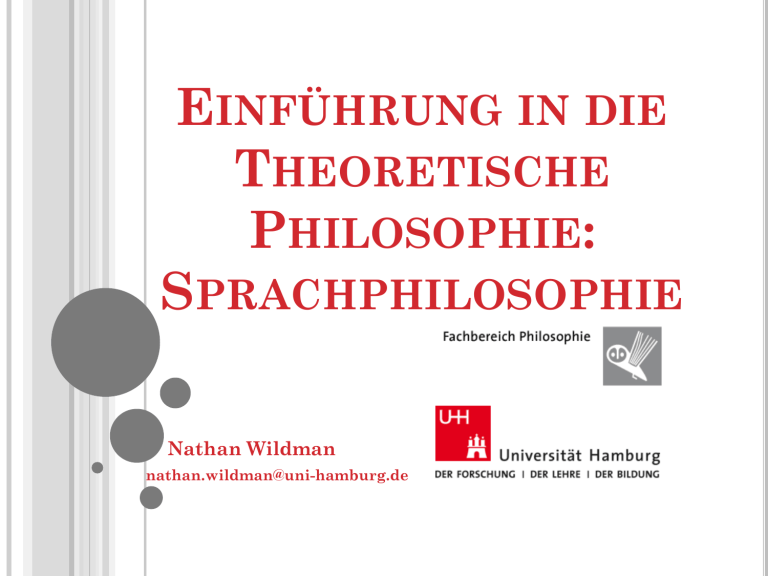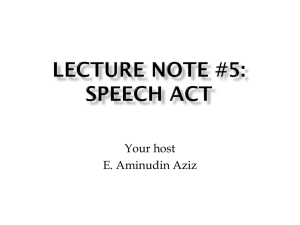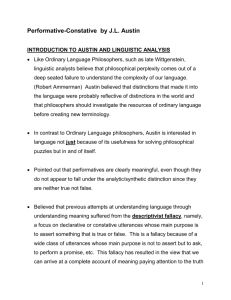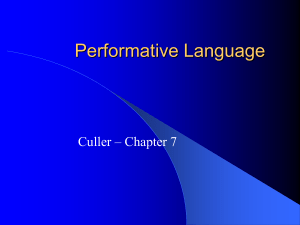Austin on Performative Utterances ()

E
INFÜHRUNG IN DIE
T
HEORETISCHE
P
HILOSOPHIE
:
S
PRACHPHILOSOPHIE
Nathan Wildman nathan.wildman@uni-hamburg.de
A USTIN ’ S
P ERFORMATIVE
U TTERANCES
Or, doing by saying
T HE P LAN
1.
Review Grice
Searle’s Objection
2.
Historical Background for Austin
Logical Positivism
3.
Austin’s Distinction
Performatives vs Constatives
4.
Saving the Distinction?
Two attempts to define the difference
5.
Conclusions
The Foundational Question:
What explains why ‘S ’ means what it does in L?
Grice’s answer: a speaker’s intentions fix the meanings of an expression!
The project of reducing talk of meaning to speaker intentions (or other kinds of mental intentionality) is known as intention-based semantics.
G RICE ‘ S A NALYSIS
Grice’s proposal: S meant nn
(1) by x that P iff
S uttered x intending for his audience to form the belief that
P; &
(2)
(3)
S also intended that his audience recognize that’s what he intended to do; &
S also intended that his audience form the belief that P at least partly because they recognize that’s what he intended to do.
Slightly shortened: A uttered x with the intention of inducing a belief by means of the recognition of this intention
G RICE ‘ S A NALYSIS
As Grice later puts it, we can distinguish between:
Relativized meaning, the explication of which essentially involves reference to word users or communicators
Non-relativized meaning, where no such reference is required
Non-relativized meaning is secondary, being reducible to relativized meaning; and no corresponding analysis or reduction in the other direction is possible
G RICE ‘ S A NALYSIS – S EARLE ‘ S O BJECTION
Suppose that I am an American soldier in WW II and that I am captured by Italian troops. And suppose also that I wish to get these troops to believe that I am a German officer in order to get them to release me. What I would like to do is to tell them in German or Italian that I am a German officer.
But let us suppose I don’t know enough German or Italian to do that. So I … put on a show of telling them that I am a
German officer by reciting those few bits of German that I know, trusting that they don’t know enough German to see through my plan. Let us suppose I know only one line of
German, which I remember from a poem I had to memorize in a high school German course. Therefore I, a captured
American, address my Italian captors with the following sentence: “Kennst du das Land, wo die Zitronen blühen?”
G RICE ‘ S A NALYSIS – S EARLE ‘ S O BJECTION
Searle claims that the three clauses of Grice’s account of meaning are satisfied: I intend to produce a certain effect in them, namely, the effect of (i) believing that I am a German officer; and I intend to produce this effect
(iii) by means of their (ii) recognition of my intention.
But when I say “Kennst du das Land, wo die Zitronen blühen?” I don’t mean nn
‘I’m a German Officer’ – rather,
… because what the words mean is, “Knowest thou the land where the lemon trees bloom?” … Meaning is more than a matter of intention, it is also a matter of
convention. [Searle, “What is a Speech Act?”]
G RICE ‘ S A NALYSIS – S EARLE ‘ S O BJECTION
Upshot: a purely intention based semantics isn’t going to work – we need something about conventions.
Many interesting things to talk about here:
http://plato.stanford.edu/entries/convention/#ConLan
Searle’s ‘What is a Speech Act’
Lewis’s Conventions
Blackburn’s Spreading the Word
T HE P LAN
1.
Review Grice
Searle’s Objection
2.
Historical Background for Austin
Logical Positivism
3.
Austin’s Distinction
Performatives vs Constatives
4.
Saving the Distinction?
Two attempts to define the difference
5.
Conclusions
H ISTORICAL B ACKGROUND
The Linguistic Turn
Began with Frege prior to the turn of the 20 th century
This idea really hit it’s stride with the Logical
Positivists, who, influenced by Frege through Russell,
Carnap, and Wittgenstein, had propagated the view that the study of linguistic meaning was the proper starting point for philosophy.
Language and meaning were supposed to elicit initial agreement better than other traditional starting points.
H ISTORICAL B ACKGROUND
Logical Positivism
The Principle of Verification
The meaning of a sentence is its method of verification or confirmation.
The Principle of Analyticity
Statements of logic and mathematics, together with statements that spell out meaning relations, are true purely in virtue of their meaning and provide no information about the world.
H ISTORICAL B ACKGROUND
Therefore, for a statement to be cognitively meaningful, it must satisfy one of the following conditions: a) b) it is an analytic truth or falsehood (self-contradictory statements), or it is capable of being verified as true or false by experiential means (procedures which ultimately can be reduced to what can be directly ascertained to be true or false by means of the senses).
Wittgenstein:
‘Whereof one cannot speak, thereof one must be silent.’
H ISTORICAL B ACKGROUND
Tyson: Do you know who I am?
I’m the Heavy-
Weight Champion of the World.
Ayer: And I am the
Wykeham Professor of Logic. We are both pre-eminent in our field. I suggest that we talk about this like rational men…
H ISTORICAL B ACKGROUND
Quine’s Attack:
The analytic-synthetic distinction is bunk, and the fundamental idea of verifying a sentence by itself is ridiculous. Rather,
Our statements about the external world face the tribunal of sense experience not individually, but only as a corporate body. [Quine, Two Dogmas]
Confirmation holism: sentences cannot be confirmed singularly, they can be confirmed or falsified only in
relation to other sentences, in the context of theories
T HE P LAN
1.
Review Grice
Searle’s Objection
2.
Historical Background for Austin
Logical Positivism
3.
Austin’s Distinction
Performatives vs Constatives
4.
Saving the Distinction?
Two attempts to define the difference
5.
Conclusions
A USTIN ’ S D ISTINCTION
Austin's primary target: the verificationist presumption that the only meaningful sentences are those which express true or false statements, together with the
Descriptive fallacy: it is a fallacy to treat all utterances as declarative statements and view those that don’t have a truth value as nonsensical
Austin’s response: you can’t reduce meaning to truth; many sentences both in the language of philosophy and in everyday language aren’t intended to be true or false, so approaching them from the perspective of truth is to misunderstand what they’re doing
A USTIN ’ S D ISTINCTION
There are a load of declarative sentences that, just as with questions and orders, don’t lend themselves to being analysed via truth and falsity!
Performatives: a class of utterances whose members i.
look like statements ii.
iii.
iv.
would be so-classed grammatically (i.e, grammatically, they are declarative) are neither true nor false are not nonsense
A USTIN ’ S D ISTINCTION
(1)
I bet you €5 that you can’t stand on one foot for a 10 minutes!
(2)
(3)
I name this ship Titanic (uttered by the Queen while breaking a bottle of champagne over the bow of a ship)
I will (uttered by a bride in response to the question
‘do you take this man…?’ during a wedding ceremony)
Sentences like these make no statement about the way the world is and thus aren’t open to being true/false
A: I name this ship Titanic
B: That’s not true!
A USTIN ’ S D ISTINCTION
Monty Python and the Holy Grail
When King Arthur makes Bedevere a knight, he says
‘I dub thee Sir Bedevere…’
This is a performative utterance – the act of uttering the sentence IS the act of knighting!
A USTIN ’ S D ISTINCTION
Contrast the above with sentences like
(4)
The M40 connects London and Birmingham
(5)
(6)
The Queen named this ship Titanic
I eat a lot of pastries
If any sentence is susceptible to having its meaning pinned down to being true or false, then (4) is
(5) has obvious similarities with (2), but no ship gets named by an utterance of (3b)
Uttering (6) is not the same as eating a lot of pastries.
A USTIN ’ S D ISTINCTION
This led Austin to divide utterances into two distinct classes: on the one hand there are utterances like those in (1) – (3) which are used to do things—Austin called these performative utterances.
On the other hand, there are utterances like those in (4)
– (5) which are used to report things – what Austin called constative utterances.
A USTIN ’ S D ISTINCTION
Note that while there isn’t much point in asking whether
(1) – (3) are true or false, that doesn’t mean that they can’t in some sense go wrong.
Imagine that rather than being uttered by the Queen wielding a bottle of champagne, the following is uttered by me as I board a ferry on the Elbe:
I name this ship ‘Titanic 2: Electric Boogaloo’
Does my utterance have the same effect as the Queen’s does? Clearly not – I don’t have the authority to go around naming ships!
A USTIN ’ S D ISTINCTION
Similarly, imagine that the Queen is out walking her corgis one day, and she says the following to one of them:
I dub thee Sir Thorgi
In this case, the speaker has the appropriate authority to perform the action in question, so what’s gone wrong?
Answer: (British) knighting can only apply to humans
(Unlike Norwegian Knighthood)
A USTIN ’ S D ISTINCTION
Upshot : in order for a performative utterance to ‘work’, certain conditions must be met.
Austin called these felicity conditions—they’re the conditions that must be in place for the act in question to come off successfully (or felicitously).
He offers several criteria for determining when a performative utterance is felicitious or infelicitious.
A USTIN ’ S D ISTINCTION
Rules: performatives are governed by rules, usually implicit in normative social behaviour
Constitutive Rules: If X violates a constitutive rule for performing a speech act of type A, then X has failed to perform an act of type A at all
Regulative Rules: If X violates a regulative rule for performing a speech act of type A, the X performs an act of type A, but X’s act is defective
A USTIN ’ S D ISTINCTION
(i)
The relevant constitutive rules do not exist: the conventional procedure which by our utterance we are purporting to use must exist – there must be a convention to the effect that one can, e.g., marry by saying “I do” in the appropriate circumstances a.
b.
c.
Saying “I divorce you” does not count as an act of divorcing because no such procedure exists
Offering someone a pencil does not count as an act of prooffering marriage because such a procedure doesn’t exist
Naming a ship by urinating upon it…
A USTIN ’ S D ISTINCTION ii.
The constitutive rules are violated: the circumstances in which we purport to invoke the procedure must be appropriate for its invocation/ in addition the procedure correctly and completely carried through a) b) c)
Saying “I pick George” does not count as picking George if
George is not playing
Saying “I appoint you counsel” when you have been appointed already
Saying “I will” when the other says “I won’t’ counts as a case in which the procedure is not completed
A USTIN ’ S D ISTINCTION iii.
The regulative rules are violated: failure of sincerity conditions – certain procedures are designed for people who hold certain beliefs or have certain feelings or intentions; insincerity occurs when you use one of these formulae without the requisite feelings or intentions a) b)
Saying “I congratulate you” when not glad the person addressed has had a certain success
Saying “I promise to do X” when you don’t have the least intention of doing X or of believing it is feasible
A USTIN ’ S D ISTINCTION iv.
v.
Misunderstanding: You may not hear what I say or you may understand me to refer to something different from what I intended
Non-responsibility: there is a general overriding consideration that, as we are performing an act when we issue these performative utterances, we may of course be doing so under duress or in some other circumstances which make us not entirely responsible for doing what we are doing
If the felicity conditions aren’t met, it might result in a misfire or an abuse. In the case of a misfire, the whole act fails to come off; in the case of an abuse, the act comes off but in some way insincerely
T HE P LAN
1.
Review Grice
Searle’s Objection
2.
Historical Background for Austin
Logical Positivism
3.
Austin’s Distinction
Performatives vs Constatives
4.
Saving the Distinction?
Two attempts to define the difference
5.
Conclusions
S AVING THE D ISTINCTION ?
Austin has discovered a class of utterances – the performatives – which behave differently from another class – the constatives.
Problem:
How do we distinguish the performatives from the
constatives?
Spoiler: there’s no systematic way to work out which utterances are performative and which are constative, so that distinction had better be dropped – all utterances, not just performatives, are used to perform a range of different acts.
S AVING THE D ISTINCTION ?
Grammatical Criteria?
Notice that, in all our performative examples, their main verbs are all in the first person singular of the present tense. Building on this, perhaps all performative utterances must have their verb in the first person singular present!
Problem: (4) – (6) have their verb in the right tense and person and yet are clearly not performative…
So this grammatical point isn’t sufficient. But maybe it’s necessary!
S AVING THE D ISTINCTION ?
Problem: some performative utterances don’t have a first person singular present tense verb form
(7)
(8)
(9)
Passengers are warned to cross the track by the bridge only
Notice is hereby given that trespassers will be prosecuted
You were off-side
Both (7) and (8) are third person, in the passive voice.
And (9)’s isn’t even in the right tense, let alone the right person! Yet they’re all performative…
S AVING THE D ISTINCTION ?
Argument I: Utterances of any grammatical shape at all can be used as performatives
I declare you off-side
You’re off-side
Off-side
In the right circumstances, any of these can perform the action of declaring someone off-side, yet the first is a performative of the classic type we saw at the very beginning, the second is a passive with no obvious performative marker, and the third is a one-word utterance!
S AVING THE D ISTINCTION ?
Argument II: in different circumstances, the same sentence can be used both performatively and constatively.
A: Will you come to my party?
B: I promise to come
A: How do you get me to throw all these parties?
B: I promise to come
The same sentence is used performatively in one exchange, but constatively in the other.
S AVING THE D ISTINCTION ?
A Second attempt – Explicit vs. Primary
Explicit performatives—things like the sentences in
(1) which have explicitly performative verbs like ‘name’,
‘bet’, ‘dub’ and so on
Primary performatives: sentences like
I’ll come (uttered as a promise)
There’s a bull in the field (uttered as a warning)
Guilty (uttered by the foreman of a jury)
S AVING THE D ISTINCTION ?
It should be possible to distinguish by looking for a particular kind of asymmetry between the first person present tense singular and all other persons/tenses:
(10)
I name this ship Titanic
(11)
She named this ship Titanic
The former can be used to perform the act of naming a ship, the latter only to report a fact.
So, using this criterion, it’s possible to list all the verbs with this particular characteristic!
S AVING THE D ISTINCTION ?
Once completed, all primary performative utterances can then be paraphrased as explicit performatives, i.e. as utterances containing explicit performative verbs.
For example, you get the utterances and paraphrases:
I’ll come
⇝
I promise I’ll come
Guilty ⇝ I pronounce you guilty
S AVING THE D ISTINCTION ?
One problem: there are some cases where we’ve a performative utterance yet where is no explicit paraphrase.
Insulting: an utterance of ‘I insult you’ does not itself count as an insult.
Another problem: the asymmetry test is not always entirely conclusive, as there are some verbs which are part performative, part constative:
‘I blame you for everything’. Am I performing an act of blaming, or am I simply telling you how things are?
S AVING THE D ISTINCTION ?
Biggest problem: it allows verbs such as ‘I state …’ into the class of performatives
I state that this ship is named ‘Titanic’
Question: why is this a bad outcome?
(Note: same problem as the ‘Hereby’ test)
S AVING THE D ISTINCTION ?
Given that any test Austin can come up with seems to fail, the conclusion he’s inexorably drawn towards is that the distinction between performatives and constatives is impossible to maintain.
…But surely there is, at least, one big difference between them; indeed, the very difference that started us off in the first place – Constrastives are either true or false, performatives are either felicitous or infelicitous!
Surely there’s a difference between truth and felicity?
S AVING THE D ISTINCTION ?
Not necessarily, since constatives are apt to misfire too!
(12)
I bequeath you my original Picasso
Problem: I don’t have any! Therefore, misfire.
(13)
All of John’s children are monks
Consider a situation in which John doesn’t have any children. There is something wrong about an utterance of
(13) in this situation – a presupposition has not been met, such that (13) appears to fail in the same way as (12).
(14)
'The cat is on the mat but I don't believe it is."
Like making a promise without intending to keep it
S AVING THE D ISTINCTION ?
On the flip-side, performatives also have a general dimension of correspondence with fact: we evaluate performatives (as well as statements) in terms of correspondence to the facts.
A justified warning
A sound verdict
A empty threat
But surely truth is an all or nothing type thing—a proposition is either true or false—whereas felicity is a matter of degrees!
S AVING THE D ISTINCTION ?
But what about a claim like
(14)
France is hexagonal.
Is (14) true or false? Likely answer: it’s roughly true— it’s not absolutely true, but it’s certainly not false.
And that suggests that truth may not really be quite such an all or nothing property after all.
Further, there doesn’t seem to be as massive a gap regarding truth (understood as corresponding to the facts) & felicity as one might first think…
S AVING THE D ISTINCTION ?
Upshot: the distinction between performatives and statements breaks down.
There are two questions we ought to ask about statements:
(1) what was the meaning of an utterance; and
(2) what was the force of the utterance
In addition to the old doctrine about meanings we need a new doctrine about the possible forces of utterances!
H OW TO D O T HINGS WITH W ORDS
Locutionary Content: the propositional content of an utterance
Locutionary act: acts of expressing certain propositional contents, performed by means of performing referential and predicative acts
Illocutionary Force: classification of an act as stating, promising, betting, etc.
Illocutionary act: communicative acts – successful in virtue of listener understanding; this is not caused by the utterance but is part of what the utterance is
Perlocutionary act: non-communicative acts performed by means of performing illocutionary acts (alarming, annoying, insulting, etc.) to achieve something









